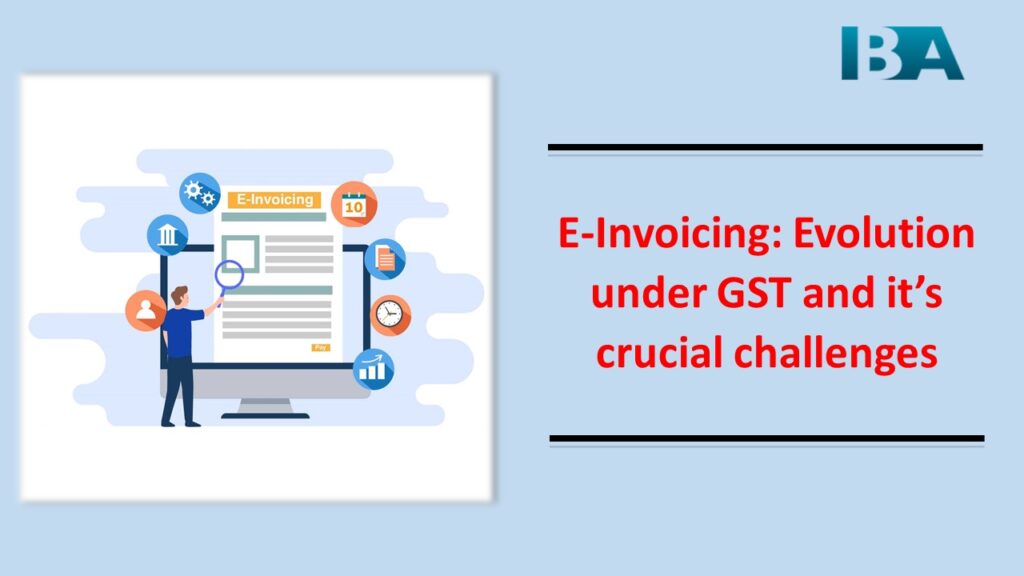- August 5, 2021
- Posted by: IBA LLP
- Category: Articles, Indirect Tax

The government, in order to reduce compliance burden, enhancing ease of doing business and checking tax evasion, introduced the e-invoicing provisions in the GST Law, the implementation of which would eventually address the issue of fake invoices.
Under e-invoicing, the registered taxpayers must generate invoices for business-to-business (B2B) transactions on their internal system and then register such invoices over NIC (National Informatics Centre) Invoice registration portal (IRP).
The GST council, in its 35th meeting dated 21st June 2019, decided to implement system of e-invoicing to specified categories of persons. The Central Board of Indirect tax and Customs (hereafter referred as ‘CBIC”) formally notified the system of e-invoicing under GST vide notification No. 68/2019 Central tax dated 13 December 2019, which inserted sub rule (4), (5) and (6) under Rule 48 of the Central goods and services tax (“CGST”) rules, 2017 for implementation of e-invoicing.
E-invoicing is mandatory from 1st October 2020 for all businesses whose aggregate turnover has exceeded the 500crore limit in any of the previous financial years from 2017-2018 onwards. From 1st January 2021, e-invoicing became applicable to businesses exceeding Rs 100 crore turnover limit in any preceding financial year from 2017-2018 onwards. Likewise, it was extended to businesses having aggregate turnover more than 50 crore from 1st April 2021.
However, CBIC has specifically exempted certain class of taxpayers irrespective of their limit vide notification No. 13/2020-Central tax dated 21.03.2020 read with FAQ on e-invoicing recently issued by CBIC such as Insurance companies, banking companies, SEZ units, passenger transportation services, GTA etc.
Timeline for generation of E-invoicing is yet to be notified
Requirement of generating IRN on “T+1” basis has been waived off by government on the demand of taxpayers. Hence, presently the registered taxpayers are required to generate IRN before issuing the invoice to recipient or movement of goods.
E-invoicing may pose additional burden on small businesses: –
E-invoicing will pose a serious problem as well as additional burden on small business as still large number of small business firms lacks funds to invest in advance IT infrastructure thereby lacks digital literacy. Even, various small villages and towns still stands behind in terms of proper broadband connection, which is a necessity for e-invoicing.
It will increase both CAPEX as well as OPEX cost of small businesses in order to either get well equipped in-house IT team or to outsource it.
Lack of flexibility for cancellation and amendment of e-invoice
Setting up of e-invoicing mechanism would serve the purpose of transparency but its implementation will be a roller coaster ride for taxpayers as they may face various issues in implementation phase.
There might a situation when incorrect IRN has been generated on the IRN portal. Here the real test of flexibility and adaptability of e-invoicing system comes into light.
Though e-invoice enables invoices to be cancelled but there is a cap of 24hrs i.e. after 24 hours any cancellation is not possible.
Due to above restriction, there could be variance in IRP and GST reported.
Also, if a valid e-way bill exists for IRN for goods in movement then it cannot be cancelled. Moreover, once IRN generated, it cannot be generated for same invoice number, hence IRN cannot be re-generated for cancelled invoice. Instead, fresh invoice needs to be raised.
On similar line of cancellation of e-invoice, it also poses restriction on amendment of IRP. Hence, in case of any change in details of invoice reported to IRP, can be carried out while filing GSTR-1.
Conclusion:
Introduction of E-invoicing can be considered as historical event for a trillion-dollar economy with both organized as well as unorganized sectors. It will embark a new journey towards transparency and adequacy of business transactions.
It is well understood that no provision can be free from escape clause so there is always scope for issue to be addressed post implementation.
However, unlike GST, it is introduced in phased manner to give time to industry players. Still there are many issues to be addressed by government to streamline the e-invoicing mechanism.
Author : Kunal Aggarwal
